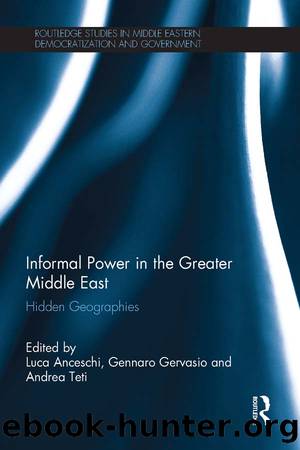Informal Power in the Greater Middle East: Hidden Geographies by Luca Anceschi & Gennaro Gervasio & Andrea Teti

Author:Luca Anceschi & Gennaro Gervasio & Andrea Teti [Anceschi, Luca & Gervasio, Gennaro & Teti, Andrea]
Language: eng
Format: epub
Tags: Social Science, Middle Eastern, Political Science, World, Regional Studies, General
ISBN: 9780415624367
Google: KnuHtgAACAAJ
Goodreads: 13714440
Publisher: Routledge
Published: 2012-11-01T00:00:00+00:00
Tribalism as âcounter-insurgency on the cheapâ
Alex de Waal (2004: 25â27) described the government-sponsored efforts to contain the rebellion in Darfur after 2003 as âcounter-insurgency on the cheapâ. De Waal was referring to the Sudanese governmentâs use of tribal militias to fight the rebellion in Darfur which broke out in 2003 when the Sudanese Liberation Movement/Army and the Justice and Equality Movement launched strikes against military installations. In response, as most authoritative sources agree (Flint 2009; Suleiman 2011: 195), the Sudanese Armed Forces â most likely under direct instruction from President Omar al-BashÄ«r (âUmar al-Bash â r) or from his deputy Vice President Ali âOsman Mohammed Taha (Ali âUthmÄn Muhammad Taha) â unleashed tribal militias against civilians and rebels alike in a bid to bring Darfur to heel. One reason why Sudan-watchers were so confident in their assessment that the government was involved with tribal militias â also known as the Janjaweed â was that they had seen exactly the same strategy for fighting rebellions in the Sudan before. Almost two decades earlier, the Sudanese government sought out âtribalâ groups in Kordofan and Darfur as allies in the war against the Sudanese Peopleâs Liberation Movement/Army (SPLM/A) (Lesch 1998). Again, in 1988, the Sudanese government armed tribal militias against the Nuba, leading to a humanitarian disaster and massive population transfer (Mohamed Salih 1995: 71â78). M.A. Mohamed Salih, for one, wrote as early as 1989 about the dangers that would ensue if the government continued to rely on tribal militias to fight insurgencies (Mohamed Salih 1989: 68â74). What many analyses of the Sudanese governmentâs instrumental use of tribal militias rely on is an unchanging notion of âtribeâ and identity in Darfur. A closer examination reveals how âtribesâ returned as the state first retreated and then attempted to reassert itself with tribal militias re-emerging as formal institutions of the Sudanese state.
The militarization of tribes in Darfur occurred at a time of serious instability. The 1980s, generally speaking, was a decade marked by bloodshed and mass immiseration across many parts of the world. The Cold War and the neo-liberal turn combined to leave a mark on the Third World which even today remains visible. Sudan was no exception, and could be said to offer an exemplification of the cost of both war and of economic crisis on a society. Darfurâs tribalism was born out of colonial policies and manipulation by post-independence governments, but it also emerged out of the events of the 1980s, when the almost complete collapse of the Sudanese state in Darfur led to chaos, and as war, famine and banditry became common across the region, Darfur became known in the Sudan as the âwild westâ (âSudan: The wild Westâ 1988: 6).
The breakdown or the collapse of the state in Darfur played some part in re-tribalizing communities that had experienced mobility during the years of economic growth and state development. The drought and subsequent famine that wreaked havoc across most of the Sahel in the mid-1980s was also a factor. Darfur had experienced
Download
This site does not store any files on its server. We only index and link to content provided by other sites. Please contact the content providers to delete copyright contents if any and email us, we'll remove relevant links or contents immediately.
Cecilia; Or, Memoirs of an Heiress — Volume 1 by Fanny Burney(32446)
Cecilia; Or, Memoirs of an Heiress — Volume 2 by Fanny Burney(31875)
Cecilia; Or, Memoirs of an Heiress — Volume 3 by Fanny Burney(31861)
The Great Music City by Andrea Baker(31550)
We're Going to Need More Wine by Gabrielle Union(18976)
All the Missing Girls by Megan Miranda(15604)
Pimp by Iceberg Slim(14403)
Bombshells: Glamour Girls of a Lifetime by Sullivan Steve(13983)
Talking to Strangers by Malcolm Gladwell(13238)
Norse Mythology by Gaiman Neil(13221)
Fifty Shades Freed by E L James(13165)
For the Love of Europe by Rick Steves(13154)
Mindhunter: Inside the FBI's Elite Serial Crime Unit by John E. Douglas & Mark Olshaker(9215)
Crazy Rich Asians by Kevin Kwan(9177)
The Lost Art of Listening by Michael P. Nichols(7413)
Enlightenment Now: The Case for Reason, Science, Humanism, and Progress by Steven Pinker(7244)
The Four Agreements by Don Miguel Ruiz(6643)
Bad Blood by John Carreyrou(6560)
Weapons of Math Destruction by Cathy O'Neil(6156)
